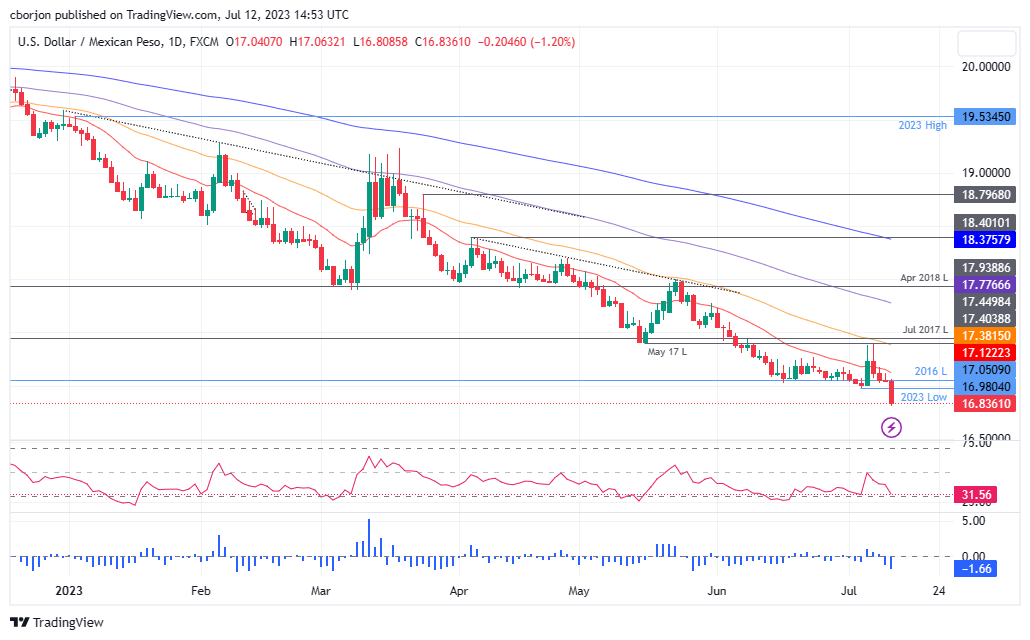USD/MXN plummets to multi-year lows on soft US CPI, upbeat Mexican Industrial Production
|
- USD/MXN plunges below 17.0000 as softer US inflation data reduces expectations of further rate hikes, while upbeat Industrial Production in Mexico boosts MXN.
- US CPI report shows inflation decelerating faster than expected, easing pressure on the Fed for aggressive tightening.
- Minnesota and Richmond Fed Presidents express concerns about high inflation and stress the need to combat it through rate increases.
USD/MXN plummets below the 17.0000 figure as a softer-than-expected inflation report in the United States (US) has traders paring bets of further rate hikes. Also, upbeat Industrial Production (IP) data in Mexico was cheered by Mexican Peso (MXN) bulls. The USD/MXN is trading at multi-year lows, exchanging hands at 16.8386 after printing a daily high of 17.0632, with more than 1% losses.
Unexpectedly low CPI figures in the US alleviate pressures for aggressive tightening of monetary policy
The US Department of Labor (DoL) showed inflation is decelerating at a higher pace, as the June Consumer Price Index (CPI) report revealed. CPI came at 3.0%, below estimates of 3.1%. Excluding volatile items like food and energy, the so-called core CPI rose by 4.8% YoY, beneath forecasts of 5.0%, and lower than May’s 5.3%. Data eases pressure on the US Federal Reserve (Fed) to continue tightening monetary policy aggressively, as most speakers throughout the week stressed the need for two rate increases. Nevertheless, traders pared November’s meeting chances for a quarter of a percentage rate hike, with odds dropping from 38.2% to 25% after the CPI report, as shown by the CME FedWatch Tool.
The central bank bonanza continued with Minnesota and Richmond’s Fed Presidents Neil Kashkari and Thomas Barkin crossing the wires. Thomas Barkin said that inflation is too high and emphasized he’s comfortable doing more to tackle inflation, while Kashkari noted that the inflation fight must be won and that if inflation gets higher, rates must be raised further.
The greenback plunges across the board, with the US Dollar Index down 0.94%, at 100.703, at its lowest level since April 2022, weighed by falling US Treasury bond yields, which are nosediving.
On the Mexican front, Industrial Production rose 1% in May from April. It was above estimates of a 1.9% expansion on yearly figures. It came at 3.9%, flashing a robust economy benefiting from a possible nearshoring, which has failed to gain more pace, as investors eye the 2024 general election.
USD/MXN Price Analysis: Technical outlook
From a technical perspective, the USD/MXN is set to continue to weaken as price action continues to show the Mexican Peso (MXN) strength, with traders eyeing the October 2015 swing low of 16.3267. Still, speculators will face solid support at 16.5000. Although the Relative Strength Index (RSI) shows the indicator approaching oversold conditions, it still warrants further USD/MXN downside. Contrarily, if USD/MXN buyers enter the market, they must reclaim the 17.0000 mark to have the opportunity to shift the pair’s bias to neutral.
Information on these pages contains forward-looking statements that involve risks and uncertainties. Markets and instruments profiled on this page are for informational purposes only and should not in any way come across as a recommendation to buy or sell in these assets. You should do your own thorough research before making any investment decisions. FXStreet does not in any way guarantee that this information is free from mistakes, errors, or material misstatements. It also does not guarantee that this information is of a timely nature. Investing in Open Markets involves a great deal of risk, including the loss of all or a portion of your investment, as well as emotional distress. All risks, losses and costs associated with investing, including total loss of principal, are your responsibility. The views and opinions expressed in this article are those of the authors and do not necessarily reflect the official policy or position of FXStreet nor its advertisers.
